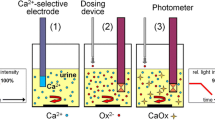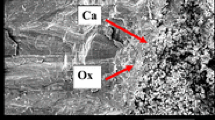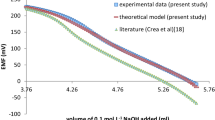Summary
A method has been developed for inducing and quantifying calcium oxalate crystallisation in whole human urine. The propensity of a given urine to induce crystal formation was described in two ways: 1) its ability to resist spontaneous nucleation of calcium oxalate crystals was assessed by titrating 20 mls of the urine with increasing quantities of sodium oxalate (0–150 μmol) to determine its practical metastable limit. This limit was inversely related to the endogenous calcium concentration. 2) its capacity to inhibit crystal growth was quantified by determining the rate of growth of calcium oxalate crystals precipitated in response to a fixed oxalate load (30 μmol) above its metastable limit. The crystals produced were predominantly calcium oxalate dihydrate and were morphologically identical to those occurring naturally in urine. Citrate had no effect on the metastable limits of 3 urines examined, but markedly inhibited crystal growth. Pyrophosphate had a similar effect on crystal growth, and in addition, raised the metastable limit of one of the urine samples.
Similar content being viewed by others
References
Baumann JM, Wacker M (1980) The direct measurement to inhibitory capacity to crystal growth of calcium oxalate in undiluted urine and other inhibitor containing solutions. Urol Res 8:171–175
Boyce WH, Garvey FK, Norfleet CM (1955) The metal chelate compounds of urine. Am J Med 19:87–95
Fleisch H (1978) Inhibitors and promoters of stone formation. Kidney Int 13:361–371
Hallson PC, Rose GA, Sulaiman S (1983) Pyrophosphate does not influence calcium oxalate or calcium phosphate crystal formation in whole concentrated urine. Urol Res 11:151–154
Hallson PC, Rose GA, Sulaiman S (1983) Raising urinary citrate lowers calcium oxalate and calcium phosphate crystal formation in whole urine. Urol Int 38:179–181
MacGregor EA, Bowness JM (1971) Interaction of proteoglycans and chondroitin sulphate with calcium or phosphate ions. Can J Biochem 49:417–425
Markovic M, Komunjer L (1979) A new method to follow crystal growth by Coulter Counter. J Cryst Growth 46:701–705
Pak CYC, Ohata M, Holt K (1975) Effect of diphosphonate on crystallization of calcium oxalate in vitro. Kidney Int 7: 154–160
Robertson WG, Peacock M, Marshall RW, Marshall DH, Nordin BEC (1976) Saturation-inhibition index as a measure of the risk of calcium oxalate stone formation in the urinary tract. N Engl J Med 294:249–252
Robertson WG, Peacock M, Nordin BEC (1968) Activity products in stone-forming and non-stone-forming urine. Clin Sci 34:579–594
Robertson WG, Peacock M, Nordin BEC (1969) Calcium crystalluria in recurrent renal-stone-formers. Lancet II:21–24
Ryall RL, Ryall RG, Marshall VR (1979) Interpretation of particle growth and aggregation patterns obtained from the Coulter Counter: A simple theoretical model. Invest Urol 18: 396–400
Ryall RG, Ryall RL, Marshall VR (1984) Calculation of crystal growth and crystal aggregation when both processes occur simultaneously. In: Ryall RL, Brockis JG, Marshall VR, Finlayson B (eds) Urinary stone. Churchill Livingstone, London Edinburgh
Tiselius H-G (1981) The effect of pH on the urinary inhibition of calcium oxalate crystal growth. Br J Urol 53:470–474
Tompkins D, Toffaletti J (1982) Enzymic determination of citrate in serum and urine, with use of Worthington “Ultrafree” device. Clin Chem 28:192–195
Author information
Authors and Affiliations
Rights and permissions
About this article
Cite this article
Ryall, R.L., Hibberd, C.M. & Marshall, V.R. A method for studying inhibitory activity in whole urine. Urol. Res. 13, 285–289 (1985). https://doi.org/10.1007/BF00262658
Accepted:
Issue Date:
DOI: https://doi.org/10.1007/BF00262658




